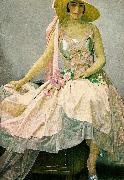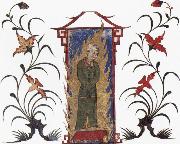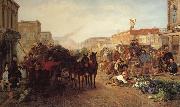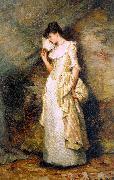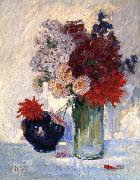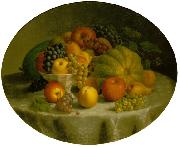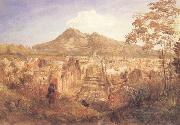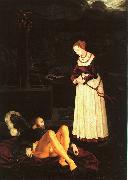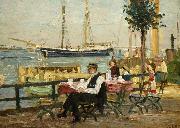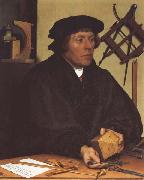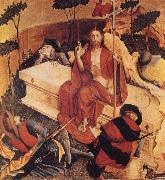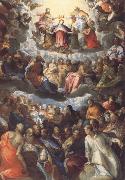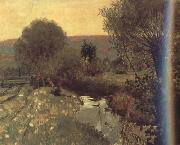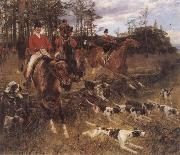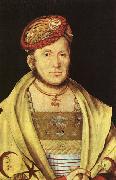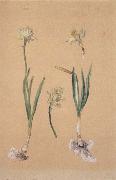|
|
|
|
|
|
|
|
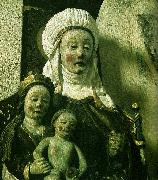 |
haaken gullesons
|
|
Ytterlännäs parish, in the province of Ångermanland, belonged to the Archdiocese of Uppsala in the Middle Ages, but has been part of the Diocese of Härnösand since that was formed in 1647. The two churches of he parish, the old one from the early 13th century, and the new one from 1848-1854, are located between the communities of Nyland and Bollstabruk, within Kramfors Municipality.
The Ytterlännäs New Church taken into use in 1854 is an example of the style known as a tegnarlada ("Tegnor barn") - spacious, white, clean, neo-classical. The Ytterlännäs Old Church (Ytterlännäs Gamla Kyrka) dates from the 1200s and features medieval vaults, wall-paintings and wooden sculptures, and baroque furnishings including the unusual feature of two galleries; the Ytterlännäs Madonna is regarded by experts as a particularly fine example of the work from the Hälsingland workshop of Haaken Gulleson, all in an excellent state of preservation thanks to the church's being abandoned after 1854. |
|
|
|
|
|
|
|
|
|
 |
HALS, Dirck
|
|
Dutch painter (b. 1591, Haarlem, d. 1656, Haarlem). |
|
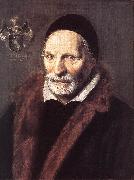 |
HALS, Frans
|
|
Dutch painter (b. 1580, Antwerpen, d. 1666, Haarlem). |
|
|
|
 |
Hamilton Easter Field
|
|
(1873-1922) was an important American artist, teacher, author, critic, collector and patron of the arts |
|
|
|
|
|
|
|
|
|
 |
hans arp
|
|
Jean Arp / Hans Arp (16 September 1886 ?C 7 June 1966) was a German-French, or Alsatian, sculptor, painter, poet and abstract artist in other media such as torn and pasted paper.
Arp was born in Strasbourg. The son of a French mother and a German father, he was born during the period following the Franco-Prussian War when the area was known as Alsace-Lorraine (Elsass-Lothringen in German) after it had been returned to Germany by France. Following the return of Alsace to France at the end of World War I, French law determined that his name become Jean. |
|
|
|
|
|
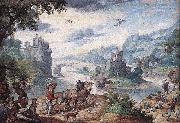 |
Hans Bol
|
|
(1534 - 1593), Flemish artist, received his early training from his two uncles who were also painters. He then was the apprentice to a Mechelen watercolorist and tempera painter at the age of fourteen. Because Boles watercolors became so widely reproduced, he began creating miniatures on parchment. The technique earned him many international clients and a good income. In addition, Bol also produced several oil paintings, illuminated manuscripts, drawings, and engravings. He preferred to create landscapes, mythological, allegorical and biblical scenes, and genre paintings.
Bol was a mannerist, which followed the High Renaissance.
One of his most famous works of art is Landscape with the Fall of Icarus, made with watercolours on paper. It was inspired by Ovid's Metamorphoses, in which the ancient myth of Icarus is told. The painting is a marvelous example of the art of landscape. Subtle colour transitions, skilful perspective and effective contrasts between foreground and background, and human figures and the forces of nature, lend this miniature painting a cosmic dimension.
Bol chose the Icarus theme on several occasions. It was also subject of one of his paintings, which described in detail and highly praised by Karel van Mander in the 17th century. Although Bol was once an important and admired painter, we only know him through his small drawings and watercolours. Most of his paintings appear to have been lost. This miniature is all the more important, because it probably produces the painting referret to by Van Mander, which may have been his masterpiece. Consequently, Bol ought to be viewed not only as a superior miniature painter, but above all as an important artist who played a key role in the development of landscape art.
|
|
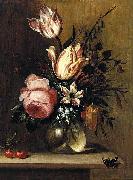 |
Hans Bollongier
|
|
(1600-idem, 1645) was a Dutch Golden Age still life flower painter.
Bollongier was born in Haarlem. According to the RKD little is known of his early life. He became a member of the Haarlem Guild of St. Luke in 1623, and in 1675 his younger brother Horatio was named as his beneficiary. He was a specialist in bouquets of blooms. Paintings attributed to him that are not flower- or fruit still lifes are likely the work of his brother Horatio.He was an important influence on the later flower painters known as the monogrammist JF and Anthony Claesz II. He painted during a period of great productivity for Haarlem painters, during the decades after Karel van Mander published his Schilderboeck there. In Karel van Mander's book, there were a set of rules to follow to create good paintings and good drawings. Bollongier developed his own style and still observed all of these rules. His paintings were very popular, but his work was not regarded as such by contemporary Haarlem painters. As a genre, still life painting was considered inferior to historical allegories.
His work today is considered part of the proof that Tulip Mania took place, although there is reason to believe that this is also just part of early Haarlem tourist propaganda. Even as early as the 17th century, gentry from Amsterdam, Leiden, and places farther away enjoyed visiting the tulip fields of Haarlem in the Spring, and paintings of tulips were as popular as the bulbs.
|
|
 |
Hans Burgkmair
|
|
(1473 - 1531) was a German painter and printmaker in woodcut.
Burgkmair was born in Augsburg, the son of painter Thomas Burgkmair
and his son, Hans the Younger, became one too. From 1488 he was a pupil of Martin Schongauer in Colmar, who died during his two years there, before Burgkmair completed the normal period of training. He may have visited Italy at this time, and certainly did so in 1507, which greatly influenced his style. From 1491 he was working in Augsburg, where he became a master and opened his own workshop in 1498.
Hollstein ascribes 834 woodcuts to him, mostly for book illustrations, with slightly over a hundred being "single-leaf", that is prints not for books. The best of them show a talent for striking compositions, and a blend, not always fully successful, of Italian Renaissance forms and underlying German style. From about 1508 he spent much of his time working on the woodcut projects of Maximilian I until the Emperor's death in 1519. He was responsible for nearly half of the 135 prints in the Trumphs of Maximilian, which are large and full of character. He also did most of the illustrations for Weiss Kunig and much of Theurdank.
He was an important innovator of the chiaroscuro woodcut, and seems to have been the first to use a tone block, in a print of 1508.His Lovers Surprised by Death (1510) is the first chiaroscuro print to use three blocks.and also the first print that was designed to be printed only in colour, as the line block by itself would not make a satisfactory image. Other chiaroscuro prints from around this date by Baldung and Cranach had line blocks that could be and were printed by themselves.He produced one etching, Venus and Mercury (c1520),etched on a steel plate, but never tried engraving, despite his training with Schongauer. |
|
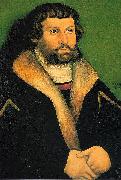 |
Hans Cranach
|
|
(ca. 1513-1537), also known as Johann Lucas Cranach, was a German painter, the oldest son of Lucas Cranach the Elder. German art historian Christian Schuchardt, who discovered his existence, credits him with an altar-piece at Weimar, signed with the monogram "H. C.", and dated 1537. He died at Bologna in 1537. Luther mentions his death in his "Table Talk", and Johann Stigel, a contemporary poet, celebrates him as a painter.
|
|
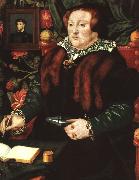 |
Hans Eworth
|
|
Flemish Northern Renaissance Painter, active 1540-1573 |
|
|
|
|
|
 |
Hans Heysen
|
|
Sir Hans Heysen, OBE (8 October 1877 - 2 July 1968) was a well-known German Australian artist. He was particularly recognized for his watercolours of the Australian bush. He won the Wynne Prize for landscape painting a record nine times.
|
|
|
|
|
|
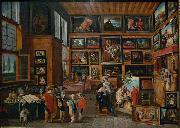 |
Hans Jordaens
|
|
(1555 - 1630), was a Flemish Baroque painter whose religious works are often confused with that of other painters with the same name.
|
|
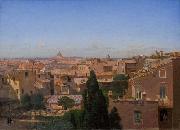 |
Hans Jorgen Hammer
|
|
(29 December 1815, Copenhagen - 28 Januar 1882, Rome) was a Danish artist who specialized in genre painting.
Following an apprenticeship with J.G. Berg in Copenhagen, Hammer was admitted to the Danish Academy in 1828. In 1841, he became a student of Christoffer Wilhelm Eckersberg who remained a close friend. He was awarded the Academy's little silver medal in 1842 and the large silver medal the following year. Det sidste Læs, his entry for the Neuhausen Prize in 1845, was bought by Statens Museum for Kunst but it was not until 1837 that he was awarded the prize with Bønder forsamlede til Lystighed en Søndag Eftermiddag under aaben Himmel.
Hammer was an industrious but rather serious and thoughtful artist. His avid approach to detail slowed down his work considerably. After the outbreak of war in 1848, he became a naval officer. With a stipendium from the Academy, he travelled to Italy in 1857 where he painted Torvet i Ariccia efter Solnedgang, considerably enhancing his reputation in Denmark. The painting was acquired by Statens Museum for Kunst in 1863. Other notable works are Axsamlersken (1866) and Postbudet med det længe ventede Brev (1877). After recovering from a serious illness, he travelled to Rome in 1881 but died there the following year
|
|
 |
Hans Knieper
|
|
painted Portrait of Frederick II of Denmark and Norway in 1581
|
|
|
|
 |
Hans Makart
|
|
(May 28, 1840 - October 3, 1884) was a 19th century Austrian academic history painter, designer, and decorator; most well known for his influence on Gustav Klimt and other Austrian artists, but in his own era considered an important artist himself and was a celebrity figure in the high culture of Vienna, attended with almost cult-like adulation.
Makart was the son of a chamberlain at the Mirabell Palace, born in the former residence of the prince-archbishops of Salzburg. Initially, he received his training in painting at the Vienna Academy between 1850 and 1851 from Johann Fischbach. While in the Academy, German art was under the rule of a classicism, which was entirely intellectual and academice clear and precise drawing, sculpturesque modelling, and pictorial erudition were esteemed above all. Makart, who was a poor draughtsman, but who had a passionate and sensual love of color, was impatient to escape the routine of art school drawing. For his fortune, he was found by his instructors to be devoid of all talent and forced to leave the Vienna Academy.
He went to Munich, and after two years of independent study attracted the attention of Karl Theodor von Piloty, under whose guidance, between 1861 and 1865 he developed his painting style. During these years, Makart also travelled to London, Paris and Rome to further his studies. The first picture he painted under Piloty, Lavoisier in Prison, though it was considered timid and conventional, attracted attention by its sense of color.
In his next work, The Knight and the Water Nymphs, he first displayed the decorative qualities to which he afterwards sacrificed everything else in his work. His fame became established in the next year, with two works, Modern Amoretti and The Plague in Florence. His painting Romeo and Juliet was soon after bought by the Austrian emperor for the Vienna Museum, and Makart was invited to come to Vienna by the aristocracy.
The prince Von Hohenlohe provided Makart with an old foundry at the Gusshausstraße 25 to use as a studio. He gradually turned it into an impressive place full of sculptures, flowers, musical instruments, requisites and jewellery that he used to create classical settings for his portraits, mainly of women. Eventually his studio looked like a salon and became a social meeting point in Vienna. Cosima Wagner described it as a "wonder of decorative beauty, a sublime lumber-room". His luxurious studio served as a model for a great many upper middle-class living rooms.
The opulent, semi-public spaces of the Makart atelier were the scene of a recurring rendezvous between the artist and his public. The artist became the mediator between different levels of society: he created a socially ambiguous sphere in which nobility and bourgeoisie could encounter one another in mutual veneration of the master, and aestheticized the burgeoning self-awareness of the bourgeoisie by means of historical models drawn from the world of the aristocracy. In this way, an artist like Makart lived out the image that high society had created of him. Makart is considered by many as being the first art star, referred to by contemporaries an "artist prince" (Malerferst) in the tradition of Rubens.
Makart became the acknowledged leader of the artistic life of the Vienna, which in the 1870s passed through a period of feverish activity, the chief results of which are the sumptuously decorated public buildings of the Ringstraße. He not only practised painting, but was also an interior designer, costume designer, furniture designer, and decorator, and his work decorated most of the public spaces of the era. His work engendered the term "Makartstil", or "Makart style", which completely characterized the era.
In 1879, Makart had designed a pageant organised to celebrate the Silver Wedding Anniversary of the Imperial couple, emperor Franz Josef and his wife Elisabeth of Bavaria he designed, single-handed, the costumes, scenic setting, and triumphal cars. This became known as the "Makart-parade", and had given the people of Vienna the chance to dress up in historical costumes and be transported back into the past for a few hours. At the head of the parade was a float for artists, led by Makart on a white horse. His festivals became an institution in Vienna which lasted up until the 1960s. In the same year as the first parade he became a Professor at the Vienna Academy.
Makart's painting The Entry of Charles V into Antwerp caused some controversy, because Charles V was depicted arriving in a procession surrounded by nude virgins; the offense was the mistaken idea that the nudes had no place in the modern scene. In the United States, the painting fell under the proscription of Anthony Comstock, which secured Makart's fame there. The American public desired at once to see what Comstock was persecuting, so they could tell whether he was acting correctly or in error.
Salzburg's Makart Square, or Makartplatz, was named after the painter.
|
|
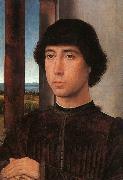 |
Hans Memling
|
|
Netherlandish Northern Renaissance Painter, ca.1435-1494 |
|
|
|
|
|
|
|
|
|
|
|
|
|
 |
Hans Smidth
|
|
Hans Ludvig Smidth (2 October 1839, Nakskov - 5 May 1917, Frederiksberg) was a Danish painter. He is remembered above all for his paintings of Jutland and its local inhabitants.
Smidth was the son of the city bailiff of Skive, Edvard Philip Smidth, and the brother of Verner Frederik Læssøe Smidth who founded the cement concern F. L. Smidth & Co. After graduating from school, he began to study medicine but gave it up in favour of art. In 1861, he entered the Danish Academy where he studied under Niels Simonsen. In 1866, he began to experience financial difficulties and left the Academy to continue his studies himself, painting scenes of Limfjord and the moors of Jutland. He first exhibited at Charlottenborg in 1867 with two landscape paintings and continued to exhibit there over the years. His works depicted country life in Jutland, most of them with an emphasis on animals and local figures. He had a talent for form and detail but his use of colour was rather dry, dimishing the appeal of his paintings to the general public. In 1870-71, he studied under Vilhelm Kyhn. As the years went by, Smidth's style developed considerably, earning him the Neuhausen Prize in 1877 for En fremmed spørger om Vej i Bondegaarden paa Heden which was not only technically impressive but showed a fineness of tone. His increasing acceptance as a master of painting in Jutland paved the way for his reputation at the national level.
In fact Smidth had to wait until the year 1900 before he experienced full recognition. That year the Danish Art Society arranged a special exhibition of the artist's work although he was now 60. Unexpectedly 290 of the 300 works sketches and drawings exhibited were sold. In retrospect, his paintings are free of historical or mythical figures, they do not interpret scenes along the lines of the Skagen Painters. They simply depict the views of the people and the countryside as he saw them. His paintings show he had the same respect for the land as the peasants themselves. |
|
|
|
|
|
 |
Hans von Aachen
|
|
was a German mannerist painter.
His name is derived from the birth place of his father, Aachen in Germany. Other variations of the name include Johann von - and - von Achen and various concisions like Janachen, Fanachen, Abak, Jean Dac, Aquano, van Aken etc.
Hans von Aachen began painting in Germany as a pupil of the Flemish master E. Jerrigh. He then moved to Italy in 1574 to study further. He toured Rome and Florence, but eventually settled in Venice. He initially became a pupil of Kaspar Rems, but soon decided to develop his own mannerist technique, by studying Tintoretto and Michelangelo's followers. However, during all of his life he was influenced by the style of Bartholomeus Spranger and Hendrick Goltzius who dominated the art scene in Germany at the time.
He returned to Germany in 1588 where he became well known as a painter of portraits for noble houses. He painted several works for Duke William V of Bavaria. He married Regina, the daughter of the composer Orlando di Lasso in Munich. In Munich he came into contact with the Imperial Court in Prague. In 1592 he was appointed official painter of Rudolph II, Holy Roman Emperor. However, Von Aachen only moved to Prague in 1601, where he stayed painting commissions from Emperor Rudolph II, and later from Matthias I.
Amongst van Aachens pupils were Peter Isaak and Joseph Heinz. His works have been copied by Wolfgang Kilian, Dominicus Custos and Jan Sadeler.
|
|
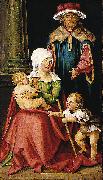 |
Hans von Kulmbach
|
|
(real name Hans Suess or Hans Seß) was born around 1480 in Kulmbach, Franconia and died previous to Dec. 3, 1522 in Nuremberg. Hans von Kulmbach was the artist who created the Krakew St. John's Altar.
Kulmbach probably arrived in Nuremberg around 1505. He received instruction by Jacopo de' Barbari, who for a time worked in Nuremberg. Von Kulmbach then apprenticed with Albrecht Derer and after Derer retired from painting altarpieces in 1510 Kulmbach took over most of his commissions. Kulmbach had his own workshop in Nuremberg and at times worked in Krakew. He also created artworks for emperor Maximilian I and for Margrave Casimir Hohenzollern von Brandenburg-Kulmbach. His best works were stained-glass windows in churches, such as the Maximilian stained-glass, Margrave stained-glass at St. Sebald in Nuremberg, the Welser stained-glass at the Frauenkirche and the Nikolaus altar at Lorenzkirche. In 1511 he finished the St. Mary's altar at Skałka in Krakew. The Catherine and St. John's altar also in Krakew, are among his best works.
|
|
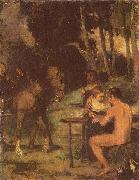 |
Hans von Marees
|
|
(24 December 1837 - 5 June 1887) was a German painter. He mainly painted country scenes in a realistic style.
Von Marees was born in Elberfeld, Germany. At age 16, he was sent to the Berlin Academy. In 1857, he moved to Munich.
In 1869, he visited France, the Netherlands and Spain. He served in the Franco-Prussian War (1870-71) and then lived in Berlin and Dresden for a while. In 1873, he decorated the library walls of the newly built Naples Zoological Institute in Italy. The next year, he moved to Florence.
He died in Rome at the age of 49 and is buried in the Protestant Cemetery there.
|
|
|
|
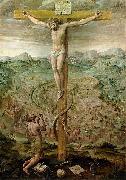 |
Hans Vredeman de Vries
|
|
(1527 - c. 1607) was a Dutch Renaissance architect, painter, and engineer. Vredeman de Vries is known for his publication in 1583 on garden design and his books with many examples on ornaments (1565) and perspective (1604).
Born in Leeuwarden and raised in Friesland, in 1546 Vredeman de Vries went to Amsterdam and Kampen. In 1549 he moved to Mechelen where the Superior Court was seating. Sebastian, his brother, was the organist in the local church. Vredeman de Vries designed ornaments for merry parades of Charles V and Philip II. Studying Vitruvius and Sebastiano Serlio, (translated by his teacher Pieter Coecke van Aelst), he became an internationally known specialist in perspective. He continued his career in Antwerp, where he was appointed city architect and fortification engineer. After 1585 he fled the city because of the Spanish occupation by Alessandro Farnese. Then the Protestants had to leave the city within two years. Vredeman de Vries moved to Frankfurt and worked in Wolfenbettel, designing a fortification and a new lay-out of the city for Julius, Duke of Brunswick-Leneburg. After his death the project was cancelled and Hans worked in Hamburg, Danzig (1592), Prague (1596) and Amsterdam (1600). On his trips Vredeman was accompanied by his son Paul and Hendrick Aerts.
Vredeman de Vries tried to get an appointment at the University of Leiden in 1604. It is not known when and where Hans Vredeman de Vries died, however, it is recorded that his son Paul was living in Hamburg when he inherited.
|
|
|
|
|







